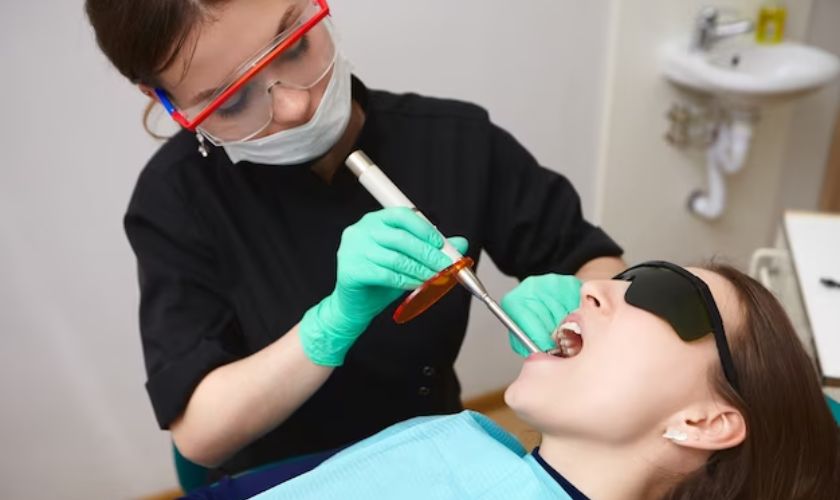(972) 378-3786
From Gingivitis To Periodontitis: Navigating The Stages Of Gum Disease Treatment

Gum disease is a common oral health issue that affects millions of people worldwide. From its initial stage, known as gingivitis, to the more severe periodontitis, understanding the stages of gum disease and the available treatments is crucial for maintaining a healthy smile. If you’re in Plano, TX, seeking reliable periodontal treatment, you’ve come to the right place. In this comprehensive guide, we’ll explore the different stages of gum disease and how Plano periodontal treatment can help you regain your oral health and confidence.
Understanding Gum Disease: A Sneaky Intruder
Gum disease, also called periodontal disease, is an infection that targets the tissues surrounding your teeth, including your gums and the bones that support them. It often begins with gingivitis, which is characterized by symptoms like red, swollen gums that bleed when you brush or floss. Gingivitis can be mild and sometimes painless, making it easy to overlook.
If left untreated, gingivitis can progress to periodontitis, a more severe form of gum disease. At this stage, the infection can lead to serious consequences, including tooth loss. Fortunately, there is hope in the form of periodontal treatment in Plano, TX, which can effectively combat gum disease and restore your oral health.
Gingivitis: The First Warning
Gingivitis is the earliest stage of gum disease. It usually occurs due to poor oral hygiene practices, such as inadequate brushing and flossing, and the accumulation of plaque—a sticky film of bacteria—on your teeth. The good news is that gingivitis is reversible with proper care and regular visits to your Plano periodontal treatment specialist.
Signs That You Have Gingivitis
Bleeding Gums
Bleeding gums are often the first sign of gingivitis. If you’ve noticed blood on your toothbrush or in the sink when you brush or floss, it’s essential not to ignore it. Healthy gums should not bleed during regular oral hygiene routines. The bleeding occurs due to inflammation and irritation of the gum tissue caused by the accumulation of plaque, a sticky film of bacteria on your teeth.
Red and Swollen Gums
Healthy gums should have a pinkish hue and a firm texture. However, when gingivitis sets in, the gums can undergo noticeable changes. They may become red, inflamed, and tender to the touch. This redness and swelling are signs that your gums are not as healthy as they should be. The inflammation and redness occur as a response to the irritation caused by bacterial toxins in plaque. Your body’s immune system attempts to fight off the infection, resulting in the characteristic redness and swelling.
Bad Breath
Persistent bad breath, also known as halitosis, can be an embarrassing consequence of gingivitis. The bacteria in plaque release sulfur compounds that contribute to foul-smelling breath. The accumulation of bacteria in the mouth, along with the inflammation of the gums, can lead to the release of unpleasant-smelling compounds. This results in chronic bad breath that can persist even after brushing and using mouthwash.
Periodontitis: When Gum Disease Gets Serious
If gingivitis goes untreated, it can escalate into periodontitis. This advanced stage of gum disease is characterized by more severe symptoms and potential damage to your oral health. Periodontitis can cause the following issues:
- Pocket Formation: As the infection progresses, pockets can form between your gums and teeth, trapping more bacteria and causing further damage.
- Gum Recession: Your gums may start to recede, exposing the roots of your teeth and making them more vulnerable to decay.
- Tooth Mobility: In severe cases, teeth can become loose and may even fall out due to the weakening of the supporting bone structure.
Treatment Options For Periodontitis In Plano, TX
Scaling and Root Planing
Scaling and Root Planing, often referred to as a deep cleaning, is a non-surgical procedure designed to remove plaque and tartar buildup from below the gumline. This treatment is typically the first line of defense against gum disease, especially in its early stages (gingivitis). Scaling and Root Planing are usually recommended when gum disease is detected in its early stages, or when gingivitis has progressed to a more severe form.
Source: Dentalk!
Periodontal Surgery
In advanced cases of gum disease, non-surgical treatments like scaling and root planing may not be sufficient to restore gum health. Periodontal surgery becomes necessary to repair damaged tissues and potentially regenerate lost bone. Periodontal surgery is mainly considered when gum disease has progressed to advanced stages (periodontitis) and non-surgical treatments have not been successful.
Laser Therapy
Laser therapy is a cutting-edge treatment option that utilizes advanced laser technology to target and remove infected gum tissue while promoting healing. Laser therapy is an option for various stages of gum disease, depending on the severity and the dentist’s assessment of the patient’s specific needs.
Gum disease is a serious oral health condition that requires prompt and effective treatment. While maintaining good oral hygiene is crucial, some cases may necessitate professional intervention. Scaling and Root Planing, Periodontal Surgery, and Laser Therapy are essential tools in the fight against gum disease. If you suspect you have gum disease or have been diagnosed with it, consult with your dentist to determine the most appropriate treatment plan tailored to your specific condition and needs. Remember that early intervention and proper management are key to preserving your oral health and maintaining a beautiful smile.
